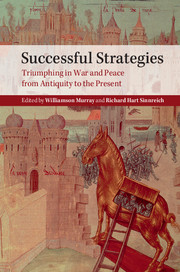Book contents
- Frontmatter
- Dedication
- Contents
- List of tables and map
- List of contributors
- Acknowledgments
- Introduction
- 1 The strategic thought of Themistocles
- 2 The grand strategy of the Roman Empire
- 3 Giraldus Cambrensis, Edward I, and the conquest of Wales
- 4 Creating the British way of war: English strategy in the War of the Spanish Succession
- 5 Failed, broken, or galvanized?
- 6 Victory by trial and error: Britain’s struggle against Napoleon
- 7 The strategy of Lincoln and Grant
- 8 Bismarckian strategic policy, 1871–1890
- 9 Dowding and the British strategy of air defense 1936–1940
- 10 US naval strategy and Japan
- 11 US grand strategy in the Second World War
- 12 American grand strategy and the unfolding of the Cold War 1945–1961
- 13 The Reagan administration’s strategy toward the Soviet Union
- Afterword
- Index
- References
12 - American grand strategy and the unfolding of the Cold War 1945–1961
Published online by Cambridge University Press: 05 June 2014
- Frontmatter
- Dedication
- Contents
- List of tables and map
- List of contributors
- Acknowledgments
- Introduction
- 1 The strategic thought of Themistocles
- 2 The grand strategy of the Roman Empire
- 3 Giraldus Cambrensis, Edward I, and the conquest of Wales
- 4 Creating the British way of war: English strategy in the War of the Spanish Succession
- 5 Failed, broken, or galvanized?
- 6 Victory by trial and error: Britain’s struggle against Napoleon
- 7 The strategy of Lincoln and Grant
- 8 Bismarckian strategic policy, 1871–1890
- 9 Dowding and the British strategy of air defense 1936–1940
- 10 US naval strategy and Japan
- 11 US grand strategy in the Second World War
- 12 American grand strategy and the unfolding of the Cold War 1945–1961
- 13 The Reagan administration’s strategy toward the Soviet Union
- Afterword
- Index
- References
Summary
In early 1947, Secretary of State George Marshall told an audience at Princeton University that “I doubt seriously whether a man can think with full wisdom and deep convictions regarding some of the basic international issues of today who has not at least reviewed in his mind the period of the Peloponnesian War and the Fall of Athens.” Marshall was drawing an analogy between the emerging Cold War of his time and the “war like no other” that had been of pivotal importance in the Greek world 2,400 years earlier. Such analogies from a previous war can provide a useful intellectual point of departure for assessment of the nature of a war upon which one is embarking, especially if that war seems peculiar at first sight.
Without due regard to differences as well as similarities, however, simple analogies can be a treacherous guide to action. Even when the similarities seem compelling, one ought to bear in mind the jibe of social-science methodologists that “anyone can draw a straight line between two dots.” We can gain greater analytical power by connecting a greater number of dots in patterns that are more complex but that still exhibit key factors to guide assessment of the dynamics of a conflict as it unfolds and selection of courses of action for winning that conflict. The premise of this essay is that one can insightfully evaluate American grand strategy in the Cold War in terms of generic factors of success gleaned from previous big wars – not just the Peloponnesian War, but also such wars as those between Rome and Carthage in the ancient world and Britain and France in the eighteenth and early nineteenth centuries as well as the two world wars of the twentieth century. As that sample suggests, “major wars” are those violent conflicts between great powers that occur for high political stakes, that have both sides seeking to put together and sustain coalitions, that spread across multiple theaters, and that involve the use of many instruments of power and influence.
- Type
- Chapter
- Information
- Successful StrategiesTriumphing in War and Peace from Antiquity to the Present, pp. 353 - 402Publisher: Cambridge University PressPrint publication year: 2014



